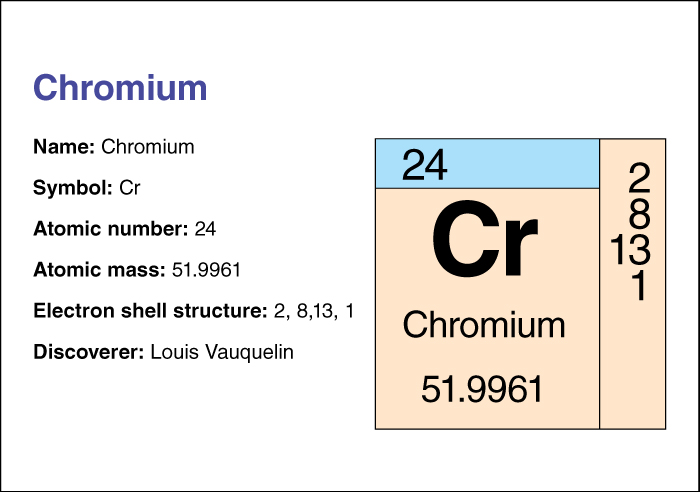Chromium, << KROH mee uhm, >> a chemical element, is a glossy, fairly soft, gray metal. It is sometimes called chrome. Chromium resists corrosion, and becomes bright and shiny when polished. For these reasons, chromium is widely used to plate (coat) other metals, giving them a durable, shiny finish. Chromium is used to plate motorcycle parts and automobile trim.

Chromium hardens steel. Chromium-steel alloys (mixtures) are used to make armor plate for ships and tanks, safes, ball bearings, and the cutting edges of high-speed machine tools. Alloys that contain more than 10 percent of chromium are called stainless steels. Stainless steel does not rust easily. It is commonly used to make eating utensils and kitchen equipment.
Chromium combines with other elements to form colored compounds. The word chromium comes from the Greek word chroma, meaning color. Traces of oxidized chromium give rubies and emeralds their characteristic red and green colors. Many chromium compounds are important in industry. Potassium dichromate is used in tanning leather. Lead chromate is a paint pigment called chrome yellow. Chromium compounds are used in the textile industry as mordants (substances that fix dyes permanently to fabrics), and in the aircraft industry to anodize aluminum (coat the metal with a thick, protective oxide film).
Chromium does not occur in nature as an uncombined metal. It is almost always found combined with iron and oxygen in a mineral called chromite. Major chromite-producing countries include South Africa, Kazakhstan, and India.
Chromium has the chemical symbol Cr. Its atomic number (number of protons in its nucleus) is 24. Its relative atomic mass is 51.9961. An element’s relative atomic mass equals its mass (amount of matter) divided by 1/12 of the mass of carbon 12, the most abundant form of carbon. Chromium melts at 1900 °C and boils at 2690 °C. The density is 7.14 grams per cubic centimeter at 20 °C. Chemists classify chromium as a transition metal . For information on the position of chromium on the periodic table, see the article Periodic table .
Louis Nicolas Vauquelin, a French chemist, discovered a compound of chromium and oxygen in 1797. He prepared the free chromium metal the following year.
